Helpful Guides on each Category

Monkey grass plant is a perennial ground-covering grass with green leaves and flowers that bring out berries. it is also called lily turf and border grass.
Monkey Grass (Liriope muscari) is from the lily family, it thrives in plant Hardiness zones 6 to 11. Monkey grass doesn’t do well in cold climates.
Monkey grass grows 10 to 18 inches high, this creates an aesthetic carpet border of green leaves, and purple, white or pink flowers where you plant it. Between July and August, they blossom.

Quick Summary
| Scientific Name | Liriope muscari |
| Varieties | Liriope, Mondo grass |
| Synonyms | Liriope, border grass, lily turf |
| Family | Liliaceae |
| Growth Rate | Medium to Invasive |
| Size | 8 – 18 inches high. |
| Bloom Time | July to August |
| Soil Type | Well drained soil |
| Toxicity | Not proven toxic |
| Pests | Snails, grasshoppers |
| Diseases | Root rot, Leaf rot, anthracnose infection |
Varieties of Monkey Grass Plant
There are different varieties of Monkey grass, each one covering a particular grass need. The one that does well even in shades, clumping grass with no need to weed and the spreading type to fill up a space.
Below are the varieties and their sub-types;
1. Liriope muscari

Liriope prefer partial to full shade and do well in most soils. They are between 8 to 18 inches high and their types are listed below;
This is the clumping variety. Very efficient in edging and boundaries for the little creeping garden. It furthermore has Variegata and Big Blue sub-varieties. These both like light and partial shade. But landscapers prefer Big Blue for some reason.
2. Liriope spicata
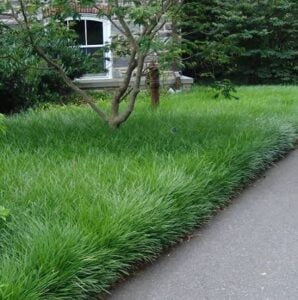
This creeping Liriope is very invasive, their rapid creeping growth gives them the ability to envelop an empty space very quickly.
3. Mondo grass (Ophiopogon japonica).
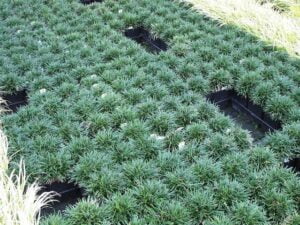
Mondo grass also thrives better in partial light to complete shade. They go with aerated soil well-drained, growing from 3 to 11 inches tall depending on the type.
During winter, it struggles to survive but in warmer areas, it maintains its fresh evergreen look. When the winter is over, to resurrect your lily turf, simply mow over the old plant, and new and good-looking foliage emerges. Do not uproot it totally to plant a new one as the effort will be unnecessary.
4. Gyoku Ryu
Grow very slowly and we’ll pin to the soil. They are shorter. Best used as design and covers between outdoor stepstones.
What is Monkey grass good for?
Liriope monkey grass is used as cover and filling between paved areas and stepstones, also it serves as a ground cover beneath trees.
As a result of its quick spreading, Liriope spicata monkey grass is often times used only when a large empty piece of land like the backyard or frontage needs to be covered.
Gardeners find Dwarf mondo grass as the perfect stand-in for turf grass. They can also be potted and placed in strategic spots for aesthetics.
How to Grow monkey grass Plant
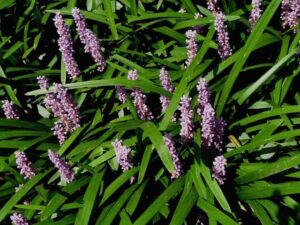
Growing in USDA zones 6 to 11, Liriopes need the right amount of water. Lily turf can survive on its own without serious monitoring.
It is best to Plant lily turf when spring sets, this will help the plant roots grow quickly into the soil. Below are the steps to plant border grass;
- To start planting them in a new place, you either get monkey grass berry seeds, a starter pack or a transplant from a friend’s garden.
- Dig up well-drained soil and bury the seeds. Watering is nice but not compulsory for already moist soil.
- Mulch the area to prevent weeds from hindering sprout growth.
- Go 20 inches into the soil when planting a clump. That will let off excess water from the roots of the border grass.
- Liriope muscari needs just enough water as too much moisture can lead to root rot and encourage mosquitoes.
- Adding little organic manure or liquid fertilizer before planting gives the soil some acidic pH which is okay for the plant.
- Plant seeds with about 9 inches of spacing as the initial room will be required to grow.
How to Transplant Monkey Grass

Border grass is either a spreading or clumping grass depending on the variety that can be divided from itself to form new plants. Mondo grass is a spreading grass that can be divided into clumps to create new specimens.
Below are the steps on how to transplant monkey grass
- With a trowel, scoop out about 8 inches wide of monkey grass cluster with attached its roots.
- put the plant in a hole broad and deep enough to contain the roots. Put earth or compost around it firmly.
- Plant each cluster with about 20 inches of spacing in between.
- Grow your Liriopes within set boundaries so it grows in a defined shape or pattern.
- Water the plant 1 to 3 times weekly.
When and How to Prune Monkey Grass

Trimming of Lily turf or Mondo grass is necessary if you are using the plant as a cover for the ground.
Between 2 to 3 years, monkey grass needs to be divided to control its required shape.
The ending of winter just before spring begins is the best time to prune or trim monkey grass. You can use garden shears or a good lawn mower to give a good low trim.
It is better to use a mower on a Liriope plant that looks damaged, mixes ugly foliage with new shoots or suffers from winter climate and needs some good grooming. This will clear everything to a low trim and start the growth of new, better shoots all over.
If using garden shears, or any handheld tool, trim the evergreen leaves to 4 inches. You can do this to be uniform to create a nice look.
Liriope muscari or lily turf as you like can recover from being trodden upon, animal, insect and disease damage very easily.
Care of Liriope Monkey Grass
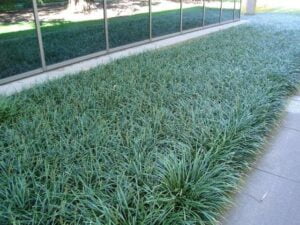
During winter, it struggles to survive but in warmer areas, it maintains its fresh evergreen look. When the winter is over, to resurrect your lily turf, simply mow over the old plant, and new and good-looking foliage emerges. Do not uproot it totally to plant a new one as the effort will be unnecessary.
pests like snails and locusts or even slugs feed on lily turf, although the effect is negligible. Any bug or insect found on the plant can simply be picked off.
Lighting requirement
Partial to full sunlight is okay for your mondo grass.
Water needs
Border grass doesn’t like much water. It even does better in drought than in waterlogged areas. Water your monkey grass twice a week.
Temperature
Excess cold is just what mondo grass cannot tolerate, otherwise, it can survive other temperatures.
Soil needs
Well-drained soil is fine, this would easily free your lily turf’s root from extra water molecules.
Diseases of Monkey Grass Liriope muscari
By now you should know that monkey grass hates so much water, one reason is that it can lead to anthracnose infection. This makes the evergreen leaves turn yellow from the tip.
Root and leaf rot can also be caused by excess water. This stressed the need for well-drained and not muddy or clumpy soil.
Is Monkey Grass Toxic to Pets and human?

Due to its tough nature – drought surviving, invasiveness that can outgrow other plants, monkey grass is not what people consider consumable.
Some dog mums may blame the backyard mondo grass for stomach upsets of their pets, but just like any other grass on the field, taking in too much monkey grass may cause little inconvenience to a pet. But there is no proof that marks the plant as poisonous.
Also with humans, if the leaf, berry or root of this plant is eaten, it is not expected to harm anyone.
eating berries of lily turf or rolling on the plant does not cause any problem for Your dog or kid.
Does Monkey Grass Attract Mosquitoes?
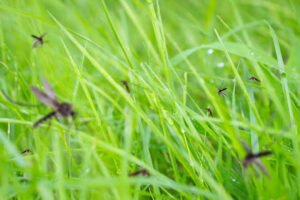
Maybe due to its dense moist leaf clusters, mosquitoes feel so welcome to live in the thick bunch of Liriope spicata.
Spraying the cover plant to get rid of mosquitoes may also kill useful insects and earthworms that aerate the soil. Planting biological repellents for mosquitoes give out scent mosquitoes hate, some of those plants are lavender, marigold and kitchen spice like rosemary or basil.
For a nice smell that mosquitoes don’t enjoy, Lavender is your go-to option
A great kitchen spice, Basil, be it cinnamon or lemon basil are the most effective natural mosquito repellent.
Rosemary, like lily turf, doesn’t require much to plant, needs little water and makes a good plant fence.
Marigolds have pyrethrum an active ingredient in repellents. They are beautiful but also practical.
Monkey Grass Berries
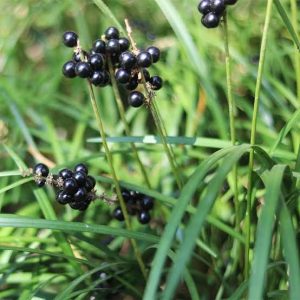
Border grass berries are gotten from the white, pink or purple flowers produced by the plant leaves as the bloom disappears.
Due to its root system – rhizome, Border grass spreads fast causing more berries to be produced.
To prevent your Liriope from having berries, cut off the flowers when they show. Monkey grass berries are not vetted for consumption.
Is Monkey Grass Invasive
Of the two varieties of monkey grass discussed before, the spreading type – Liriope spicata is really fast-spreading and invasive.
Below are useful tips to trim and control invasive Liriope;
- Trim this plant best at the end of winter or the beginning of springtime. This preserves its freshness and shields the roots from the snow. Then it grows again with the spring.
- Mow shorter lily turfs with a good lawn mower set at its highest.
- If the plant sprouted already, trim it with shears for better results. 4 inches high is a good enough trim.
Related Links
FAQs on Monkey Grass
Mondo grass is deer resistant.
monkey grass or border grass blooms better in partial light but can also thrive under full light.
plant border grass or lily turf can be planted in the fall. The ending of the snow and the beginning of spring is the best time to plant them though. That way their roots will establish in the soil before the next winter.
Monkey grass does not like winter at all and will die if exposed to serious levels.
To If you want to get rid of monkey grass, you can use a herbicide containing glysophate or manually uproot the plant.




